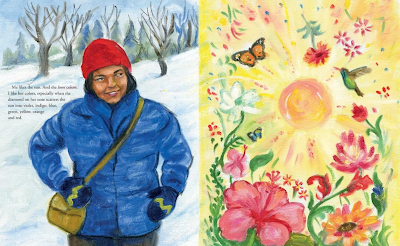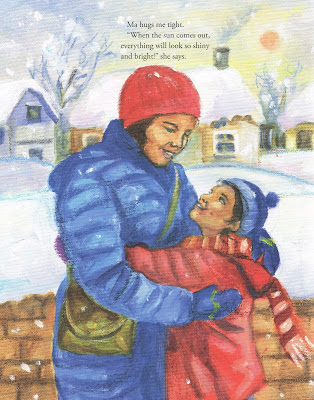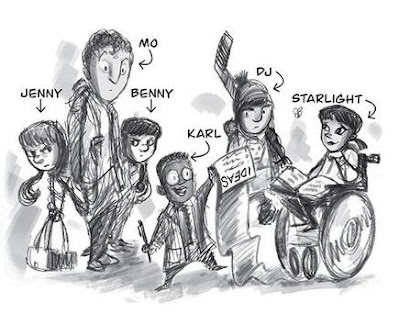Written by
Sue Farrell HollerIllustrated by
Jennifer FariaPajama Press
978-1-77278-136-6
32 pp.
Ages 4-7
November 2020
Yesterday I reviewed
Raven, Rabbit, Deer, a new picture book from Pajama Press, by author
Sue Farrell Holler and illustrator
Jennifer Faria. Today I am pleased to present an interview with the author and illustrator.
HK: At its heart, Raven, Rabbit, Deer is the story of an intergenerational relationship. Did either of you have a significant relationship with a grandparent that helped guide you in the telling of this story in words or pictures?
Sue Farrell Holler: Thank you for recognizing this as a love story – the love between grandfather and grandson, the grandfather’s love of the land and the grandson’s love of play.
I adored my maternal grandmother but, because we didn’t travel much when I was a child, I saw my grandparents only for about a week a year, yet I think I carry part of her spirit. She was a very quiet woman who liked to garden, to cook and to gather people in her home. I never had the sense that anyone was invited; it just seemed that her house was always filled with people coming and going and she fed them all.
I think there is something very special about quiet relationships, the comfort of being with someone and not feeling the need to speak. That’s how I felt around my grandmother.
I wasn’t conscious of that when I wrote the story, but certainly, that’s the type of relationship we see in Raven, Rabbit, Deer.
Jennifer Faria: Let’s just say my family history is colourful and complicated. My closest grandparent, one of my step-grandmothers, sadly passed away during the making of Raven, Rabbit, Deer. It’s disappointing, because she was one of the only members of my family who was excited about and interested in the book, and she didn’t get to see the finished product.
I have always had a good relationship with my great-aunt Glenna, who is a member of the Chippewas of Rama First Nation, as I am. She exposed me to countless cultural events in and around Toronto throughout my formative years, which likely set the stage for my artistic development. I based the look and feel of the grandfather character on her brother, my great-uncle Leonard, and she provided me with many reference photos of him.
HK: Because the species highlighted in Raven, Rabbit, Deer occur throughout Canada, did you have a specific setting or location in mind when writing or illustrating the book?
Sue Farrell Holler: Yes. I had a very clear setting in mind. The place is called Muskoseepi Park, which incidentally, means “Bear Creek” in the Cree language. It’s an 1100-acre mostly wilderness area that runs the length of the city where I live, Grande Prairie, Alberta.
Except for paved walking trails, this is primarily a natural park that’s populated by lots of animals – magpies, woodpeckers, ravens, sparrows, chickadees, geese, ducks, and herons in the summer. There are beaver, deer, moose, rabbits, muskrats, chipmunks, squirrels, mice and occasionally bear and cougar. But the animals I encounter most often are birds and mule deer.
The area is my favourite part of the city. It’s where I walk almost every day to keep tuned into nature.
Jennifer Faria: Since Sue lives in Grand Prairie, Alberta, I assumed that some of the details of the walk in the story might be local to her, so at first I was going in that direction. However, in researching which animals I would use, I found that to get a raven, a rabbit, and a deer together in the same place, in winter, it would have to be set in Ontario. So that’s what I imagined.
HK: One of the unique features of Raven, Rabbit, Deer is the inclusion of Ojibwemowin. Was the choice of Ojibwemowin related to either of your backgrounds? If so, how and was it a language spoken at home?
Sue Farrell Holler: The inclusion of the First Nations’ language is one of my favourite pieces of this story. I’m a bit of a “language nut” and I love the unhurried cadence of many of the Indigenous languages. When they are written, they are these really big words that you have to slow down to sound out and to me, that’s exactly how the language sounds, as if every word is a story.
Ojibwemowin is a new language to me, but my dad taught us a few words of Mi’kmaq – mostly the words that mean, “Hurry up!”
I am not of Indigenous heritage, but Jennifer is a member of the Chippewas of Rama First Nation.
Jennifer Faria: I am technically a member of the Chippewas of Rama First Nation, however growing up in Toronto, I was not raised in that tradition, so I don’t know the language myself. For that, I consulted with my second cousin Janice (uncle Leonard’s daughter) who is qualified and educated in these matters, and she kindly provided the translations.
HK: Raven, Rabbit, Deer is very much a sensory experience, from the visual of footprints in the snow looking like two hot dogs with two marshmallows, to the characters’ puffing as they climb a hill and the snow shower that tickles the child’s face and the cold that creeps down his neck. Even without the illustrations, your text is very evocative. Did you start the story with these sensory elements or did you start with a story arc into which they were embedded?
Sue Farrell Holler: Thank you for that!
Stories for me always start with emotion. While Raven, Rabbit, Deer appears to be a nature story, it is something a little bit deeper.
I’m very much myself and very much at peace in nature. With this story, I was thinking of how I’d like to share my experience with children and to encourage them to explore the natural world. For many kids, that will mean a city park, but it’s amazing what you can find when you slow down and really look. Key to that, of course, is knowing what to look for.
HK: How flexible does an author have to be with an illustrator’s visualization of their words? As your visions may be very different, how do you allow the two to merge?
Sue Farrell Holler: A picture book is an interesting collaboration. The author and the illustrator work with the same text, but usually in isolation.
I’m probably not supposed to say this, but the illustrations are my favourite part of a picture book. The illustrations make the words that much richer.
I love knowing a story has spoken to an artist, then seeing how she brings her perspective and experience to my words.
When I saw Jennifer’s final illustration – the one of the boy and his grandfather cuddled together – I teared up. It’s so tender and so beautiful and totally captures what this story is about.
HK: If you could ensure young readers take away one message from Raven, Rabbit, Deer, what would it be?
Sue Farrell Holler: I would hope that children come away with the sense of security and comfort that comes from loving someone.
HK: Though you’ve worked as an artist, this is your first picture book. How did you find the process of illustration from working with the text, and trying to honour the author’s message to being true to your own style and artistic expression?
Jennifer Faria: Many stages of development went into the creation of the preliminary artwork, with lots of input from the art director to help interpret Sue’s message, so that aspect fell into place pretty organically over time. With regard to my style and artistic expression, I went with the more bold, clean, and intricate look that I usually use in my portraiture (using multiple layers of acrylic paint and coloured pencil), which was probably too labour-intensive and inefficient relative to my deadline. I think it worked. However, if I get the opportunity to illustrate more books in the future, I might like to experiment with a looser, quicker style, perhaps in watercolour.
HK: It’s not unusual for authors and illustrators to look to those in their circles for names and traits. Do the grandfather and child in your illustrations reflect any family or friends?
Jennifer Faria: As I said previously, the grandfather is modelled on my great-uncle Leonard, whom I only met and spent time with a handful of times (he lived in B.C.), but he was a very strong and delightful presence, full of warmth and good humour. I used some younger photos of my son as references for the boy, and the green bear in the book is based on
my son’s own green teddy bear.
HK: I’ve seen two different book covers with different details of your name. Which is your professional artist’s name and which name do you prefer me to use in my post?
Jennifer Faria: At first I was going to go with both my maiden name and husband’s last name, but later decided it was best to stick with just my maiden name, hence the change you mention. I didn’t want to rebrand, plus I have a lot of history and equity built into ‘Jennifer Faria’ as a professional identity, so that’s the name on the published book, and the one I prefer.
• • • • • • •
Thank you, Sue and Jennifer, for your candid answers to my probing questions about Raven, Rabbit, Deer. These details about the book, both text and illustrations, as well as your own backgrounds, will undoubtedly enrich its storytelling for young readers.
Thank you also to Laura Bowman, Sales & Marketing Manager at Pajama Press, for facilitating this interview with Sue Farrell Holler and Jennifer Faria.
• • • • • • •
Also, do check out my review of Raven, Rabbit, Deer yesterday for more details about the book and to see samples of its illustrations.































